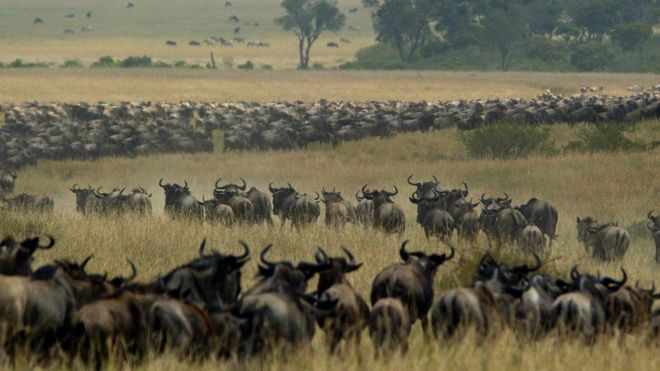Wildlife conservation and climate action are often considered as separate environmental issues, but the two are utterly intertwined. We know that combatting climate change helps save wildlife populations around the globe, but the reverse is also true: Wildlife conservation plays an essential role in regulating our climate. By saving wildlife, we help save the planet, including ourselves.

Biodiversity, ecosystems, & us
Today, the earth is experiencing its sixth mass extinction event, driven by human activity and subsequent rising global temperatures. The WWF Living Planet Report 2022 found that, in less than 50 years, the world has lost 69% of all mammal, fish, bird, reptile, and amphibian populations. The presence of an abundant variety of life on earth is critical for the health of our planet. With biodiversity, all species work together within their respective ecosystems to maintain a necessary balance and support life.
On the ground: Land animals
Many land animals promote healthy habitats that capture and store carbon to prevent further climate warming. Here are just a few:
Tigers

Tigers also play a key role in maintaining the health of the forest ecosystems that effectively sequester the carbon emissions that cause climate change. In India, forests inhabited by tigers were found to contain three times the carbon density of forests and other landscapes where the tiger populations were eradicated. Because the presence of tigers wards off human activity, the removal of tigers from landscapes makes the habitat more vulnerable.
Without these predatory big cats, humans are much more likely to infringe on the forest, degrading habitats and taking out trees. As a result, the planet loses a major carbon sink, carbon is released into the atmosphere, and warming global temperatures are exacerbated.
As top predators, tigers control populations of other species within their habitats. By preying on herbivores, tigers help keep vegetation in balance for proper ecosystem function and a healthy forest.
Elephants

As forest elephants roam, they stomp out small invasive plant species, which in turn allows large trees to grow and store carbon. Elephants also support to biodiversity by helping with seed dispersal and contribute to nutrients in the soil with their dung. It is estimated that Africa’s rain forest would lose seven percent of its ability to store carbon without elephant disturbance.
The effects of this run deeper than it may seem– if elephants were to disappear, Africa would lose the storage of about three billion tons of carbon. In fact, there is research that shows that each elephant alive today has been found to provide more than $1.75 million in carbon capturing services.
Tapirs
In the Amazon, decades of clearing trees for agriculture and ranch land, as well as wood and paper products, have left forests degraded, decimated, and in need of restoration. One surprising tool for forest rehabilitation? Tapir poop. Tapirs are large terrestrial animals that can grow to eight feet in length and frequent areas of the Amazon most in need of reseeding. Many animals participate in seed dispersal, but tapirs prefer to roam degraded forests rather than pristine lands. With a diet of herbs, shrubs, and leaves rich in nutrients, tapirs leave trails of seeds in their waste as they explore, and Amazon lands once burned or cut down are actively reseeded.
Underwater: Marine wildlife
Robust aquatic biodiversity, including the animals below, supports ecosystem functions and helps mitigate the impacts of ocean acidification caused by global warming.
Sea Otters
As they swim along the Pacific coast, otters play a vital role in a food chain that ultimately helps capture carbon from the air. Sea otters feed on sea urchins, which feed on kelp. As otters keep sea urchin populations in check, kelp can thrive and sequester more carbon. The result? Sequestration of as much as 8.7 million tons of carbon dioxide, more than double the emissions of an average coal-fired power plant over the span of an entire year. Kelp was also found to be 12 times more effective at absorbing carbon when guarded by sea otters.
Whales

Whales, like all living things, are carbon sinks, and quite large ones. Every great whale sequesters an average of 33 tons of carbon over the span of their lifetime. When a whale dies a natural death, its carbon turns into sediment that nourishes the sea floor. When whales are killed prematurely, by commercial whaling or other means, the ocean loses a significant tool for carbon sequestration in that whale and its possible future offspring.
Phytoplankton are microscopic marine organisms that have been around for over 200 million years, capture around 40% of all carbon dioxide produced globally. As whales migrate across the globe, they leave behind waste dense with iron and nitrogen, which in turn supports a healthy environment for phytoplankton to grow and help regulate our climate.
Oysters
As global temperatures rise, so do sea levels, threatening coastal communities around the world. Surprisingly, even small organisms like oysters can come to our defense. Oysters are keystone species with ripple effects on the health of their ecosystems and its inhabitants. Just one adult oyster can filter up to fifty gallons of water in a single day, making waterways cleaner. Healthy oyster reefs also provide a home for hundreds of other marine organisms, promoting biodiversity and ecosystem balance. As rising sea levels lead to pervasive flooding, oyster reefs act as walls to buffer storms and protect against further coastal erosion.
Promoting a healthier Earth
Working with partners across the globe, WWF protects threatened wildlife and preserves and restores the wild lands and freshwater they rely upon. Projects that support species like tigers, elephants, and whales are part of many multi-level efforts to combat the climate crisis. ultimately promote a healthier Earth. By conserving and restoring biodiversity in areas suffering from heavy species loss, we can help rehabilitate our planet and meet our climate goals.
By Jocelyn Kreider, WWF
